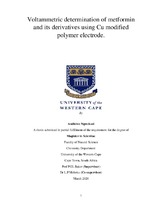| dc.contributor.advisor | Baker, P.G.L | |
| dc.contributor.advisor | Mciteka, L.P | |
| dc.contributor.author | Ngwekazi, Andisiwe | |
| dc.date.accessioned | 2021-02-24T10:07:45Z | |
| dc.date.issued | 2020 | |
| dc.identifier.uri | http://hdl.handle.net/11394/7873 | |
| dc.description | >Magister Scientiae - MSc | en_US |
| dc.description.abstract | Diabetes, a worldwide disease, is classified into two types, type 1 or insulin-dependent and type 2 or noninsulin-dependent. Based on reports published by the International Diabetes Federation, the total number of those suffering from diabetes is growing every year. Statistics predict that type 2 diabetes, currently affecting about 8% of the adult population, would spread at such a pace that by 2030, more than 40 million cases of diabetes would be found throughout the world. On the other hand, studies revealed that patients with type 2 diabetes mellitus (T2DM) have a lower incidence of tumour development than healthy controls and that patients diagnosed with cancer have a lower risk of mortality when treated with metformin. However, the frequent use of metformin with low oral bioavailability ranging between 40-60% in the intestinal environment leads to large accumulation on the enterocytes. | en_US |
| dc.language.iso | en | en_US |
| dc.publisher | University of the Western Cape | en_US |
| dc.subject | Metformin | en_US |
| dc.subject | Metformin analogues | en_US |
| dc.subject | Type II diabetes mellitus | en_US |
| dc.subject | Polypyrrole | en_US |
| dc.subject | Copper nanoparticles | en_US |
| dc.title | Voltammetric determination of metformin and its derivatives using Cu modified polymer electrode. | en_US |
| dc.rights.holder | University of the Western Cape | en_US |
| dc.description.embargo | 2024-02-24 | |

